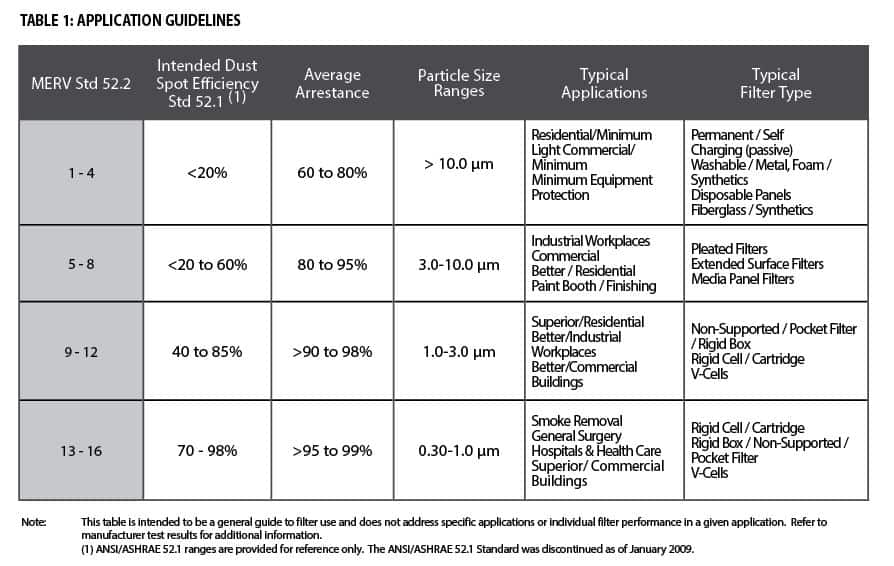While air filters and air purifiers serve a similar purpose, they are completely separate devices with strengths in different areas. For example, air filters remove particles from the air to improve indoor air quality. Air purifiers take filtration to the next level by actually sanitizing the particles, some of which are missed by standard air filters.
Understanding Air Filters
Air filters remove pollutants that contain indoor allergens like dust, mold, and bacteria from the air. On their own, HVAC air filters do not sanitize the air that passes through them.
How Do Air Filters Work?
Air filtration systems are rated on a MERV scale, or minimum efficiency reporting value scale, that measures how much a system can filter out of the air based on particle size. A lower number on the scale means that a filter can remove larger particles from the air, and a higher number means that it can filter out more, smaller particles.
Common Types of Air Filters
Some examples of air filters include standard, media, and electronic filters. We cover this in even more detail in our blog post, What Air Filtration Is Best for My Home?
Standard Filters (MERV scale: 1-4)
Common types of standard filters include pleated, washable, and more. With a low MERV scale, they filter larger pollutants such as pollen and dander. If you suffer from seasonal allergies, this is a great basic option. For more filtration, we suggest a pleated standard filter.
Media Filters (MERV scale: 8-11)
Media filters are a step up from your standard filter and a great option if you’re concerned about indoor air pollutants affecting your respiratory health. These filters use different types of media inside of them to remove pollutants from the air. An added bonus is that media filters fit easily into existing HVAC systems, making them a convenient option.
Electronic Filters (MERV scale: 13-15)
This type of filter removes indoor air pollutants by electrically charging the particles in the air. They can get rid of pet dander, bacteria, and virus particles. Electronic filters do need regular maintenance to function well, but you can contact RSC Heating and Air Conditioning to take care of it.

What Is an Air Purifier?
An air purifier is another device that removes pollutants from the air to improve indoor air quality and can be particularly beneficial to those with asthma or allergies. Air purifiers act differently than filters and are able to help air filters remove finer particles. They can also effectively reduce secondhand tobacco smoke and odors.
The main difference between air filters and purifiers is that air purifiers are capable of sanitizing the air in addition to removing harmful particles from it like filters.
How Air Purifiers Work
Air purifiers improve your indoor air quality by helping to trap pollutants, allergens, and toxins in filters. Some purifiers use additional measures to sanitize the air as well. For example, the PremierOne system utilizes UV light to kill germs. This air purifier earns a 7 out of 7 for energy efficiency, quiet level, and durability, which are things to consider when purchasing an air purification system for your home or office.
Without an air purifier, you may be exposing yourself to the following pollutants in your home:
- Mold and mildew
- Pollen
- Pet dander
- Dust mites
- Smoke from candles, fireplaces, or cigarettes
- Volatile organic compounds (VOCs)
A standard air filter can rid your home of some of these allergens. But if you want to be confident you’re breathing in the cleanest air, we recommend investing in a purifier that treats your entire house. Both devices work best together, in addition to regular house cleaning.
Common Types of Air Purifiers
There are generally two types of air purifiers: stand-alone units and whole-house units. Stand-alone units are placed in an individual room, while whole-house units can purify the entire home. Whole-house purifiers must be installed by HVAC professionals.
For the best indoor air quality, you want to invest in a purification system that can both filter and sanitize the air you breathe. Some air purifiers are capable of eliminating viruses and bacteria. It’s also important to be mindful of how often you clean and/or replace the filters in your unit to make sure it maintains the effectiveness that it is designed to deliver.
Consumer Reports provides an excellent list of the different types of air purifiers:
- Models with mechanical filters
- Models with activated carbon filters
- Electronic air purifiers
- Ultraviolet germicidal irradiation (UVGI)
- Photocatalytic oxidation (PCO)
View Whole-House Purification Options
| Standard Air Filters | Electronic Air Filters | Air Purifiers | |
| Removes larger pollutants (e.g. pollen & dust) | Yes | Yes | Yes |
| Removes smaller pollutants (e.g. dander, bacteria, & virus particles) | No | Yes | Yes |
| Kills bacteria and viruses | No | No | Yes |
Should You Invest in an Air Filter or an Air Purifier?
It’s evident that both air filters and purifiers promote clean air and healthier respiratory systems. If you’re trying to decide whether you need an air filter or an air purifier in your home, think about the size of your home and the space you have for the device. Each solution is best suited for certain settings and environments.
Do you need an air purifier if you have an air filter? If you want to increase your air quality even further, then the answer is yes. It’s important to remember that both systems work best together. They can filter particles out on their own, but when they work together, they can make all the difference in your home.
Protect Yourself from Indoor Air Pollutants
If you’re noticing a decrease in your indoor air quality, consider adding an enhanced air filter or air purifier to your home. These devices are also helpful if you’re looking for an additional way to improve allergies or feel better about your respiratory health.
Have questions about your home’s indoor air quality?




